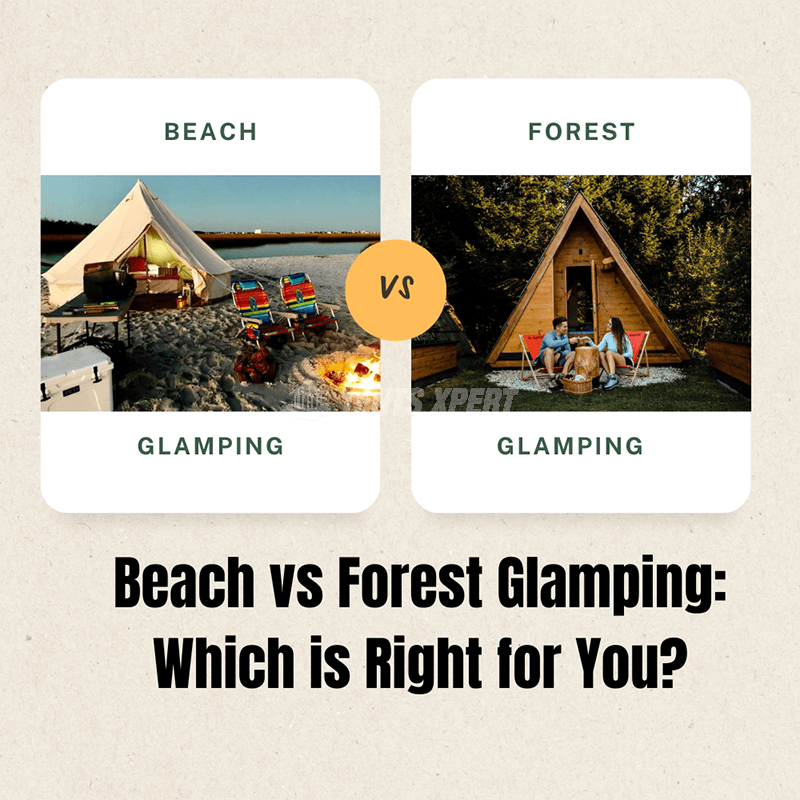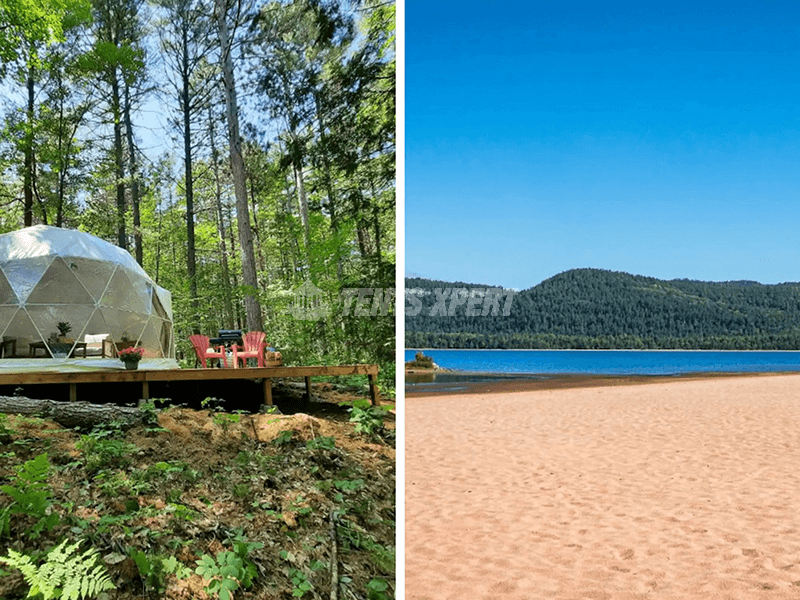May. 16, 2025
Glamping has fast become the go-to travel trend for those seeking a blend of comfort and adventure. As more people look to escape the daily grind, glamping offers the perfect middle ground between rugged nature and boutique luxury — no tent pitching required.
But glamping isn't one-size-fits-all. While some travellers crave the calming sway of forest canopies, others are drawn to the rhythm of waves crashing against the shore. The big question is: beach or forest — which glamping escape suits your travel style best?
In this guide, we’ll compare both experiences in detail — from vibe and activities to packing essentials and sustainability — helping you find the escape that fits your lifestyle, preferences, and travel goals. Whether you're planning your first glamping trip or searching for your next serene escape, we've got you covered.
| Feature | Beach Glamping | Forest Glamping |
|---|---|---|
| Scenery & Atmosphere | Coastal views, ocean breeze, golden sand | Trees, fresh air, earthy scents, shaded surroundings |
| Best For | Sun lovers, families, water sports fans | Hikers, introverts, and nature lovers |
| Weather | Warm, breezy (can be windy) | Cool, damp, occasional bugs |
| Activities | Swimming, beach yoga, kayaking, sunset walks | Hiking, forest bathing, stargazing, and campfires |
| Packing Musts | SPF, sand-resistant towel, bum bag, beach wrap | Bug spray, layers, waterproof shoes |
| Glamping Gear Ideas | Beach Towel, Towel Trapper, wrap, waterproof bum bag | Hammock, lantern, weatherproof jacket |
| Accessibility | Easier to reach, near-coastal towns | Sometimes remote, ideal for unplugging |
Forest glamping is all about peace, privacy, and feeling close to nature. Think crisp morning air, rustling leaves, and waking up to birdsong instead of alarms. It’s a great fit for those who enjoy hiking, stargazing, and the quiet stillness of the woods. Just be prepared for cooler temps, damp ground, and the occasional mosquito — layering up and packing smart is key to staying cosy and comfortable out there.
Beach glamping offers a different kind of escape — bright skies, salty air, and a laid-back vibe that’s hard to beat. It’s ideal for sun-seekers, swimmers, and anyone who finds peace near the water. Of course, spending time by the sea comes with its quirks — sand gets everywhere, breezes pick up fast, and staying organised can be a challenge.
A few well-chosen beach essentials — things that help with comfort, convenience, and keeping things tidy — can go a long way toward making your stay more relaxed.

Every glamping trip experience is enabled by a setting of choice. Each setting escapes to a world of tranquility differently. A beach setting offers one experience whereas a Forest setting offer another.
Going Forest Glamping enables the traveler to experience serenity and calmness with the soothing sounds of nature which make it easier for one to disconnect from the chaos of the world and restore focus. Spending time in forests, according to England’s Mental Health Foundation greatly reduces stress levels and aids in enhancing your mental health and wellbeing.
The coastals enable Beach Glamping which is relaxing and refreshing at the same time. Their energizing coastal breeze and captivating views of the ocean boost one’s mood while the sound of waves is both calming and motivating. According to a Bluehealth study, people spend time at the sea tends to feel significantly happier and emotionally stable, especially during walks or while sitting outside.
In conclusion, with the beaches comes light and energy while the forests come with stillness and retreat. The setting you choose is impacted by how you want to feel and focus during your trip.
Beach glamping fits best to a family, a couple, or solo traveler who seeks to unwind in warm, open spaces. It works perfectly for people who love water, want to spend time outdoors, or want to relax and listen to the ocean.
Forest glamping suits best those travelers who want to be more reflective or enjoy their own company. This is specially suited for introverts, wellness retreat guests as well as those who feel comfortable in natural surroundings. Calm environment stimulates calmness, whether it is reading a book under a tree or starting the day with a gentle stroll through the woods.
Consider how you like to spend your time: active and outdoors, or still and toes to the earth. Which option do you think captures your idea of a retreat?
Forest or beach glamping both provide a chance to disconnect with the world and spend time outdoors, however experiences will always be different relative to the surroundings.
At the beach, you might want to wake up early and do some yoga, swim in the sea, or do some stand-up paddleboarding. Some afternoons are perfect for reading with the drink in a favorite chair, your legs resting on the warm sand or gathering sea shells along the sea coast. The vibe is often buoyant and carefree.
In a forested area, the rhythm of life is slower. Mornings can be spent fully wishing by enjoying the sound of birds crooning and sipping warm drinks next to trees. While the day can be spent on numerous activities such as wandering on woody trails, lounging in a hammock with a good book, or sitting beside the fire when the sun descends. The intent is being fully present in the moment of silence and deeper engagement with nature.
All this completely relies on your preferred way to relax — if being in the sea lifts your spirit or if leaves caressing eachother in the wind soothe you.
Packing for a glamping trip isn’t like normal camping — both comfort and function matter. What you take, and how you prepare varies based on your glamping destination.
Consider a beach glamping site as an example. Items that support exposure to the sun, sand, and changing breezes are essential. Consider sunscreen, light clothing, waterproof bags for valuables, and layers that breathe for the cool evening air. A wrap and cover-up serves dual function not only for sun protection, but also for swift transitions from lounging in the sun to the beach to glamping tents. For those trying to keep things minimalist, while well-designed beach glamping gear intended for ease is a superb option.
Moving inland towards forest glamping, the focus adjusts to keeping warm, dry, and bug-free. Insect repellent, moisture-wicking base layers, and a decent thermal mug for coffee chuggers is a necessity as well. Also a must footwere with good grips — forest trails can get muddy or slippery depending on the season.
Regardless of the setting, being over-prepared tends to eliminate discomfort and hassle.

The distance you would travel, along the means of getting there, determines where you go for glamping. Also, do you wish for your destination to be secluded or easily reachable?
Coastal towns or vacation hotspots usually have beach glamping spots. These can be reached with a car or public transport. Due to some glamping spots being close to famous UK seaside towns, they make perfect weekend getaways.
If you consider heading to national parks or countryside retreats, forest glamping is usually more off the beaten path. It adds beauty and tranquility, but may require more driving or be less accessible by peripheral train or bus routes. With forest glamping becoming more popular, consider looking at what amenities are nearby.
If you plan ahead, waiting in lines gets avoided. If you are planning on visiting during the school vacations or late July, booking early is recommended. Locations near train tracks, and picturesque routes become popular fast.
Shady areas of the forest often make glamping easier by lessening the need for artificial cooling. Most forest sites have some level of compost toilets, solar lights, as well as follow leave no trace principles. This type of forest glamping is good for someone trying to lower their environmental impact.
Beach glamping also has some level of advantage. Wind and sunlight allow for beach and water activities which require the use of solar power and ventilation. However, coastal areas tend to be more fragile in terms of waste use and water consumption. This makes use of low impact gear and reusable items even more important.
No matter the choice, look for accommodation providers with a focus on sustainability and eco-friendly packaging. Small steps such as using a refillable bottle and packing travel gear can lessen the environmental impact.
Forest glamping is usually on the affordable side, especially in off grid areas or near national parks. Though the setup might be ‘basic’, the experience is often more quiet and private, which is exactly what someone looking to spend less seeking to escape the noise.
Glamping at the beach can be pricier, especially in popular coastal areas. Prices usually increase during high-demand periods which tends to be the warmer months. To keep comfortable, you may need essentials like beach-friendly sun-blocking gear and equipment to protect against windy weather.
To lower your spending, try thinking of the items you actually need. Choosing multi-functional gear will save you money while off-season traveling will also maximize the value of your trip.
When it comes to safety, having gear that’s specifically suited to your physical needs and planned terrain is critical.
Hearing other travellers' experiences can ease the decision making process regarding forest versus beach glamping. While it’s clear that personal preference plays the most significant role, there are some consistent observations in online reviews and travel forums.
Users on the reviews platforms seem to agree that the best part of forest glamping is tranquil surroundings along with deep rooted connection with nature. Many enjoy the privacy and the feeling of being completely detached from everyday noise. However, some do point out practical cons such as cold weather, difficult remote site access, or occasional bug problems, especially during the warmer months.
On the other hand, beach glamping is adored for the light fresh air and scenic views as well. Travellers tend to mention the bliss of falling asleep to waves crashing or going for a stroll on the sand in the early morning. Though this has its fair share of challenges such as wind and sand wreaking havoc, the absence of natural shade during the height of summer can become an issue.
As previously stated, everyone has different preferences which makes it easier to alter expectations. The forest can provide respite for those looking for quiet and shade while the beach offers a bright breeze.
Even custom patches for your backpack or tent bag can create a sense of adventure continuity across trips.
At the end of the day, the right glamping experience depends on what you value most in a getaway. If you’re someone who finds peace in the sound of the sea and enjoys being outdoors in the sun, beach glamping might be the better fit. If you prefer stillness, shade, and the quiet presence of nature, forest glamping offers a more grounded kind of retreat.
Both settings can be luxurious, relaxing, and deeply enriching in their own way. Each invites you to slow down, disconnect from everyday routines, and enjoy the outdoors with a touch of comfort.
If you’re still unsure, why not try both? Exploring different styles of glamping can help you discover what truly helps you unwind — whether it’s the gentle sway of tree branches or the rhythm of the waves.

Chat Now